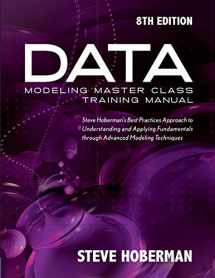
Data Modeling Master Class Training Manual 8th Edition: Steve Hoberman's Best Practices Approach to Understanding and Applying Fundamentals Through Advanced Modeling Techniques
ISBN-13:
9781634622110
ISBN-10:
1634622111
Edition:
First Edition
Author:
Steve Hoberman
Publication date:
2019
Publisher:
Technics Publications
Format:
Paperback
332 pages
Category:
Data Modeling & Design
,
Databases & Big Data
FREE US shipping
Book details
ISBN-13:
9781634622110
ISBN-10:
1634622111
Edition:
First Edition
Author:
Steve Hoberman
Publication date:
2019
Publisher:
Technics Publications
Format:
Paperback
332 pages
Category:
Data Modeling & Design
,
Databases & Big Data
Summary
Data Modeling Master Class Training Manual 8th Edition: Steve Hoberman's Best Practices Approach to Understanding and Applying Fundamentals Through Advanced Modeling Techniques (ISBN-13: 9781634622110 and ISBN-10: 1634622111), written by authors
Steve Hoberman, was published by Technics Publications in 2019.
With an overall rating of 4.2 stars, it's a notable title among other
Data Modeling & Design
(Databases & Big Data) books. You can easily purchase or rent Data Modeling Master Class Training Manual 8th Edition: Steve Hoberman's Best Practices Approach to Understanding and Applying Fundamentals Through Advanced Modeling Techniques (Paperback) from BooksRun,
along with many other new and used
Data Modeling & Design
books
and textbooks.
And, if you're looking to sell your copy, our current buyback offer is $0.3.
Description
This is the eighth edition of the training manual for the Data Modeling Master Class that Steve Hoberman teaches onsite and through public classes. This text can be purchased prior to attending the Master Class, the latest course schedule and detailed description can be found on Steve Hoberman's website, stevehoberman.com.
The Master Class is a complete data modeling course, containing three days of practical techniques for producing conceptual, logical, and physical relational and dimensional and NoSQL data models. After learning the styles and steps in capturing and modeling requirements, you will apply a best practices approach to building and validating data models through the Data Model Scorecard. You will know not just how to build a data model, but how to build a data model well. Three case studies and many exercises reinforce the material and will enable you to apply these techniques in your current projects.
Top 5 Objectives:
The Master Class is a complete data modeling course, containing three days of practical techniques for producing conceptual, logical, and physical relational and dimensional and NoSQL data models. After learning the styles and steps in capturing and modeling requirements, you will apply a best practices approach to building and validating data models through the Data Model Scorecard. You will know not just how to build a data model, but how to build a data model well. Three case studies and many exercises reinforce the material and will enable you to apply these techniques in your current projects.
Top 5 Objectives:
- Determine how and when to use each data modeling component
- Apply techniques to elicit data requirements as a prerequisite to building a data model
- Build relational and dimensional conceptual, logical, and physical data models
- Incorporate supportability and extensibility features into the data model
- Assess the quality of a data model


We would LOVE it if you could help us and other readers by reviewing the book
Book review

Congratulations! We have received your book review.
{user}
{createdAt}
by {truncated_author}


